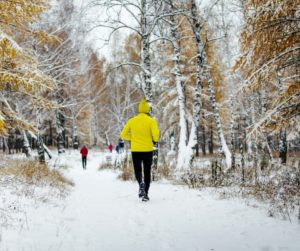Uncategorized
Cold Weather Running: How Cold is too Cold to Run Outside?
Cold Weather Running: How Cold is too Cold to Run Outside?
I used to be the kind of guy who would train outside no matter what the forecast showed. Whether it be 100 degrees or 20 below zero wind-chill, I’d be damned if I was going to let the weather stop me from training AND training outside. And as an ultra-runner in Kansas, I’ve got a taste of all types of weather. I’ve always subscribed to the notion that the extra discomfort will only help prepare me for the incomparable discomfort I’ll inevitably experience come ultramarathon race-day. Plus, you can’t control the weather on race day, right? So shouldn’t a runner prepare themselves for anything during training?
My ONLY exception to that rule would be if it were something that could actually cause long-term and permanent damage. Which, at the time, I had always heard that as long you dress appropriately in the cold, and hydrate well in the heat, there shouldn’t be any long-term repercussions. I still train outside regardless of how high the temperature climbs. However, when it comes to the cold, there is a line.
hydrate well in the heat, there shouldn’t be any long-term repercussions. I still train outside regardless of how high the temperature climbs. However, when it comes to the cold, there is a line.
Albeit it’s a very low, cold, miserable line, but a line nonetheless.
This blog will focus on that line and why I chose it. We will explore what the science about cold weather running and what experts make of the question – how cold is too cold to run outside?
While this blog focuses on running, much of the information provided applies to other disciplines of outdoor exercise as well – whether it be skiing, biking, hiking, plyometrics, or anything that gets you breathing hard.
*FYI, when I am talking about temperature, I’m talking about degrees Fahrenheit because….America. That’s what I know. I’m just getting used to converting kilometers in my head, don’t expect me to learn to do the same with Celsius!
Cold Weather Running: Impact on Lungs and Airway
Has anyone ever asked you – does running in the cold hurt your lungs? I know I’ve received that question countless times. When I first started running, I always said no and dismissed the question. I mean, I didn’t FEEL physical discomfort from breathing the air. Sure, I felt the cold, but my lungs were the least of my worries. I was typically more worried about my fingers, toes, head, and core.
A few years ago, I did (very briefly) look into the question – how cold is too cold to run outside as it applies to lung health? I quickly read that your airway would warm the air you breathe to an acceptable temperature before it actually reached the lungs. Therefore there’s nothing to worry about. I had also heard this previously from other athletes. Makes sense, so that answer was good enough for me!
However, recently (within the last couple of years), I’ve seen some articles that paint a different picture of running in the extreme cold.
It turns out that the issue with breathing extremely cold air isn’t the fact that it’s extremely cold.
It isn’t an issue with your lungs either, in that the problem has nothing to do with actually cooling the lungs, let alone freezing them. The issue is that the cold air is very dry. The extreme dryness of the cold air results in an osmotic gradient (shift of fluid concentration) in the airway that, in turn, results in inflammation. This inflammation over time can lead to exercise-induced bronchospasm, also known as exercise-induced asthma (Butcher, 2006).
 So how cold is too cold to run outside? Pretty cold, it would turn out. From what I have gathered, subzero temperatures are discouraged, but it looks like a green light for temperatures beyond zero. Of course, people with asthma or other pulmonary-related issues should always err on the side of caution.
So how cold is too cold to run outside? Pretty cold, it would turn out. From what I have gathered, subzero temperatures are discouraged, but it looks like a green light for temperatures beyond zero. Of course, people with asthma or other pulmonary-related issues should always err on the side of caution.
Other factors that influence airway damage when exercising in extreme cold;
Duration – How long the exercise session is will directly impact how drying (inflammatory) the activity is.
Intensity – Just because a cold-weather run is only 30-minutes long doesn’t mean you’re off the hook. High-intensity interval sessions will increase the rate of breathing and potentially do just as much harm as a long session in less time.
Size – Interestingly, smaller people tend to be affected more by breathing in the cold air.
Cold Weather Running: Wind Chill
So what about if the actual temperature is 17 degrees, but the wind chill or “feels like” temperature is -3 (3 below zero)? Is it too cold to run outside? This is the first question that popped into my little mind when I started researching cold weather running. It’s relatively rare for the actual temperature in Kansas to drop below zero but not too uncommon for the wind chill to hit sub-zero temperatures. First, we need to know what wind chill is actually measuring.
What is wind chill, and how does it relate to running? According to the National Weather Service, “The wind chill temperature is how cold people and animals feel when outside. Wind chill is based on the rate of heat loss from exposed skin caused by wind and cold.”
So, to be clear, wind chill doesn’t affect anything except humans and animals. It also has no influence on ambient temperature. Another way of saying this is that water will not freeze if it’s 33 degrees outside with a wind chill of 20 degrees.
Why? Because wind chill has no effect on the actual temperature for water or inanimate objects.
In fact, your skin couldn’t become frostbitten under the same circumstances either. This is because your skin would never actually get below freezing because the actual temperature is 33 degrees. However, your skin would get cold quicker because the wind is sweeping away the natural protective layer of heat created by your body.
On the other hand, if the temp was 20 degrees and the wind chill was 10 below zero, your skin WOULD become frostbitten much faster for the same reasons noted above.
What’s the moral of the story when it comes to wind chill and exposed skin? Well, don’t expose your skin. If the wind chill is below 32 degrees, frostbite is a possibility. Dress warm, layer up, cover exposed skin, and you should be good to go.

Image Credit: NOAA’s National Weather Service (NWS)
Does wind chill affect your lungs and airway while running?
It shouldn’t. As previously mentioned, wind chill only affects exposed skin. So, the air you breathe is still the actual temperature, not the wind chill temperature. The wind chill will never touch your lungs because they’re not exposed, at least, I hope not…if so, you’ve got bigger issues and should seek medical attention immediately AFTER your run. Additionally, as long as you’re not running head into the wind, with an uncovered face, with your mouth hanging open, it shouldn’t touch your airway either.
Just this last Saturday, I ran outside. The temperature was a toasty 17 degrees, but the wind was blowing 25-35 mph. Oh, Kansas, how I hate you sometimes. Anyway, 17 degrees was the ACTUAL temp. The wind chill and the “feels like” temperature read -3 degrees (I think it was colder). Remember, as far as my airway was concerned, it was 17 degrees, not -3. Green Light!
I’m not too into selfies, but I was having a good hair day, so I did take one on this particular morning.



Cute huh? Is it the most comfortable set-up? No, of course not, but I had no exposed skin, my lungs and airway were fine, and I made it through the damn run without conceding to the “avoid at all costs machine from hell,” also referred to as a treadmill.
If you ever want to calculate the wind chill yourself, check out this handy wind chill calculator by the National Weather Service.
Cold Weather Running: Hypothermia and Running Outside
Remember, you CAN get hypothermia even when it’s not freezing out. In fact, most hypothermia-related deaths occur between 30-50 degrees (National Weather Service)! Hypothermia occurs when body temperature drops below 95 degrees Fahrenheit.
Runners should pay particularly close attention to hypothermia prevention due to increased heat loss from exercise. Additionally, trail-runners or runners who venture further from civilization on their runs should exercise extreme caution. Always take a cell phone and consider carrying a pack with more layers than you think you could possibly need. Additionally, a space blanket and rain poncho are cheap, light, and potentially life-saving additions in an emergency.
As an avid hiker, backpacker, and ultra-runner, I’ve been in situations where I was many miles from any hint of civilization, had minimal cell service (if any), and was wearing every piece of clothing available. And I was STILL very cold. That’s not a great feeling. You can read about one of those situations in my wife’s blog 5 Epic Days Backpacking the Cirque of the Towers.
If you are headed to the trails, ask yourself this. If I broke my leg and had no cell service (I know, grim), would I be able to survive the cold of the night? If the answer is no, I would recommend taking more.
See this page for more information on hypothermia, including warning signs, prevention, and treatment. https://www.weather.gov/safety/cold-faqs
I still want to run outside when it’s below zero. Is there anything I can do?
For some people, it’s never too cold to run outside! I get it; I got into ultra-running because of my love for hiking and the outdoors. For me, taking to the gym for a run is a downer, for sure. Is there anything a runner can do to protect their airway when it’s otherwise too cold to run outside?
Sure. There are a few different companies that I’ve found that make masks that effectively warm the air that you breathe. If you’re interested, check out – Cold Avenger, AirTrim, or Ergodyne. I make nothing off of any of these links btw, and I’ve never actually tried any of them, so you might do some research before buying one to determine which one is best for you.
Summary: How Cold is too cold to Run Outside?
So where do I draw my line for cold weather running? If it’s single digits, or below I move it indoors. Remember, I’m talking actual temp, not “feels like” or “wind-chill” temps. Those things shouldn’t matter too much as long as you cover your skin and dress appropriately. Could I get away with exercising outside when it’s zero, or even -5 degrees without ill effects? Probably.
long as you cover your skin and dress appropriately. Could I get away with exercising outside when it’s zero, or even -5 degrees without ill effects? Probably.
But why risk it? I bet if I did experience long-lasting symptoms from a few long training runs a year (runs that absolutely would not “make or break” my training), I would feel pretty stupid.
One of my dreams is to someday hike the long trails (Appalachian, Pacific Crest, and Continental Divide) with my wife. I’m not going to do anything now that could potentially harm that future experience. It’s just not worth that.
I hate treadmills. HATE them. So much that I might be investing in one of those fancy air-warming contraptions soon. But I don’t hate them so much that I’ll risk doing irreversible damage for a training run.
Resources




